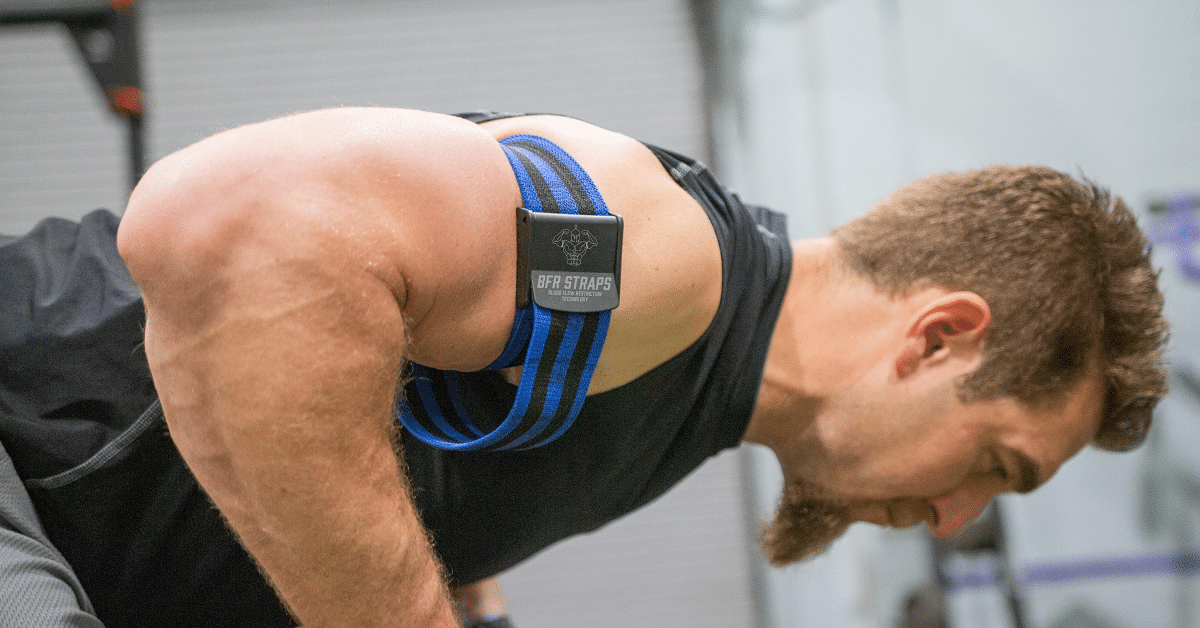Blood flow restriction training is exploding, people are getting uncanny results with more muscle mass, huge strength gains, better endurance – with shocking amounts of time saved compared to traditional workouts.
And the science is overwhelming. Unlike fitness fads, BFR training is scientifically proven with an enormous amount of peer-reviewed scientific-research studies that validate it completely. So what are the benefits?
Benefits of BFR Training VS. Traditional Training
The superior benefits of BFR training are well documented in many scientifically researched studies. Those benefits include:
- Greater Strength Development
- Faster Muscle Gains
- Increased “Cardio” Fitness
- Faster “Type II” Muscle Fiber Recruitment
- Easier Human Growth Hormone & IGF-1 Stimulation
- Greater Protein Synthesis
- Less Joint (Elbows & Knees) Stress
- Decreased Connective Tissue (Tendons & Ligaments) Stress
- Less Time to Complete a Workout
- Less Recovery Needed before Next Workout
BFR Training: Where is the Scientific Research?
Many prominent Research Journals have published the superior benefits of BFR training. Those Journals include:
- The Journal of Strength & Conditioning Research
- Strength and Conditioning Journal
- International Journal of Sports Physiology & Performance
- Scandinavian Journal of Medicine & Science in Sports
- Medicine & Science in Sports & Exercise
- Clinical Physiology & Functional Imaging
- European Journal of Applied Physiology
- American Journal of Applied Physiology
- Journal of Sports Science & Medicine
- International Journal of Sports Medicine
- American College of Sports Medicine: Exercise & Sport Sciences Reviews
- Journal of Physiology
- Frontiers in Physiology
- Experimental Physiology
- ScienceDirect Medical Hypotheses Journal
- Sports Medicine Journal
- International Journal of KAATSU Training Research
So What is BFR Training?
BFR training is a type of resistance training plan that involves putting straps, bands, or cuffs around the arms or legs. Once the straps are buckled down the training can begin. One cool thing about BFR is lighter loads of 20% – 50% of 1 rep max are optimal. Therefore, a large amount of volume (total repetitions) is required. Any exercise that you are currently performing can be used with BFR!
The mechanism of BFR training is to induce an artificial means of metabolic stress by maintaining blood flow from the heart to the muscles while inhibiting the flow back out to the heart. To do this the strap must be tight but no where near cutting off circulation to the arms or legs. Doing so will definitely have a negative effect on the body.
When blood flow gets occluded in the muscle bellies a swelling effect occurs. During this swelling metabolites such as lactate & hydrogen ions accumulate which cause an anabolic (growth) effect and assist in protein synthesis stimulating muscle growth. Also, the metabolites inhibit the muscle’s ability to use oxygen which makes the Type I muscle fibers fatigue fast. Therefore, the Type II muscle fibers are recruited very quickly. When that happens we know Growth Hormone is going to be activated.
How Does Muscle Grow?
There are 3 things that have to happen in order for your muscles to grow. The first is muscular tension. You have to apply tension to the muscles with a resistance of some sort. The tension could be applied in a variety of different ways including:
- Body Weight Exercises
- Plate loaded Barbells
- Dumbbells
- Kettlebells
- Cables
- Rubber Bands
- Weight Machines
- Hydraulic Resistance Machines
Any one of these implementations can and will facilitate muscular tension. But, without proper tension applied to the muscles they will not grow!
The second mechanism for increasing muscle growth is muscle damage. One must apply the right amount of muscle damage to stimulate growth but not so much that it causes overtraining. The damage can be applied in a few critical ways including:
- Total Time the Muscle is Under Tension (TUT)
- Repetitions per Set
- Total Training Volume (Sets x Reps x Load)
There is a fine line in damaging muscle for a natural (non-enhanced) lifter. Always err on the side of not enough. Erring on the side of too much can result in a decrease in performance, injury, or excessive delayed onset muscle soreness which would inhibit future workouts.
The third way that muscle grows is by increasing metabolic stress. A normal way to increase metabolic stress is to increase the total time under tension of the muscle. But you see Science found an easier way!
And tada…BFR is now a staple in any advanced training plan. Not because it is easy. But because you can put in the same amount of effort and get the results in half the time. The BFR training straps create an environment that expedites the metabolic stress signals of the body. Not only does it have a direct effect on the muscles located below the straps, but it has been proven to have a systemic effect on the entire body.
BFR Training Tips: The 5 T’s
Tailor
Tightness
Time
Tension
Tempo
1.Tailor
When we say the word tailor we are referring to the location in which the straps should be placed. When putting on the arm straps make sure to have them above the biceps and really as high up as possible without going over the shoulder.
The location of the leg bands is a little more inconvenient if you are a guy. The straps should be above your quad on the front, and splitting your glute-hamstring tie in on the back. With that being said the strap will wrap on the inside of your leg on the groin. Again, if you are male this will cause some readjusting but the gains are well worth it!
Location
- Legs = Deep in Hips, above Quads, splitting bottom of the Glute (butt cheek) & Hamstring, wrapped on Groin
- Arms = Deep in Armpit, above Biceps, splitting top of Triceps and Shoulder, do not go over shoulder
- Knees = Not Recommended
- Elbows = Not Recommended
- Neck = Not Recommended
2. Tightness
Compression is what we are implying here. The studies suggest that the optimal compression of the straps should be at a level of 5-7 on a scale of perceived tightness (10 being NO blood flow). More is not always better, especially with BFR.
The more compression I apply to the strap, the more I am restricting blood flow into the muscle from the heart. Remember, the whole goal is to restrict the blood flow of the veins back to the heart, not the deep arterial blood flow into the muscles.
Tourniquets are used to save peoples lives, not build muscle. This is NOT a tourniquet!
Tightness Scale
- 0-3 = Not Recommended
- 4-5 = “Cardio” Session
- 5-6 = “Strength” Session
- 6-7 = “Muscle” Session
- 8-10 = Not Recommended
3. Tension
The percentage of the 1 rep max used for BFR training is what we are explaining here. The research articles suggest that the optimal range of tension is between 20-50% of a person’s 1 rep maximum.
Obviously, repetitions are dictated by intensity so the higher the intensity the lower amount of repetitions performed and vice versa. If you need more help with BFR programming we offer three different training plans depending on your goal.
Plans include:
- Gaining “Strength” with BFR
- Building “Muscle” with BFR
- Improving “Cardio” with BFR
4. Tempo
The repetition tempo or cadence. This is a great way to increase muscle damage and metabolic stress. More time under tension increases the stress that is applied.
Think about a repetition being broken down into four parts: lowering the weight, hold at the bottom position, raising the weight back up, and holding the top position. Placing a tempo scheme on the repetitions can make it drastically harder, even with light weight.
A basic tempo repetition is as follows:
- Lower the weight for 4 seconds
- Hold the bottom position for 3 seconds
- Raise the weight back up for 2 seconds
- Hold at the top position for 1 second
- Repeat for designated amount of repetitions for that set
We really get nasty with our training plans on the tempo side of things!
You must KNOW before you can GROW!
5. Time
The total amount of time accumulated with the BFR straps. This can be calculated all at once or in interval fashion. A consecutive 20 minute session is acceptable if the straps are in the 4-5 tightness range while doing “cardio”.
The tighter they get the less time they should be worn to prevent excessive damage. Always err on the side of caution. Once the damage is done there is NO going back. You can always do intervals with them to accumulate more total time.
For example, doing your 4-5 minute Squat “Strength” session with the leg straps, then taking them off and putting on the arm straps for another 4-5 minute Bench Press “Strength” session.
Time Scale
- 4-5 minutes = “Strength” Sessions (Have links to the programming here again)
- 5-10 minutes = “Muscle” Sessions
- 10-20 minutes = “Cardio” Sessions
Safety Concerns for BFR Training?
Just like everything in life there are safety concerns with BFR training. The study by Loenneke and colleagues showed that there is NO extra safety concern with BFR training compared to traditional weight training.
It is extremely rare to get injured performing BFR training because of the low intensities used. The warnings stem from inappropriate implementation of the straps and include:
- Subcutaneous hemorrhage
- Numbness
- Rhabdomyalisis
People often ask about wrapping at the knees and elbows like powerlifters do. This is a completely different concept.
They are using it to store extra elastic energy (from the elastic band) to assist with the movement (squat or bench press). The wraps act as a spring when compressed.
BFR training protocols do NOT ever recommend wrapping at the knees or elbows. Always wrap at the upper leg and upper arm!
How to use the BFR Training Institute
Please feel free to browse our research articles page to dive in deep on BFR training.
Or go on over to the BFR Training page to see how to use the BFR straps with your everyday training exercises.
If you would like a personalized BFR training plan please contact contact@staging.bfrtraining.org.
References:
Loenneke, J., Wilson, J., Wilson, G., Pujol, T., Bemben, M. 2011. “Potential Safety Issues with Blood Flow Restriction Training.” Scandinavian Journal of Medicine and Science in Sports. 21 (4): 510-518. DOI: https://doi.org/10.1111/j.1600-0838.2010.01290.x.


